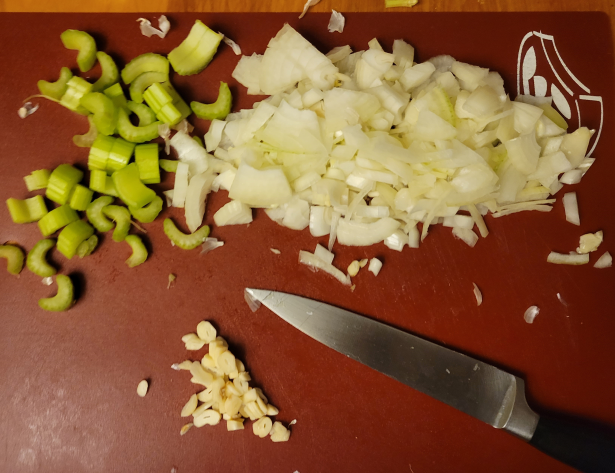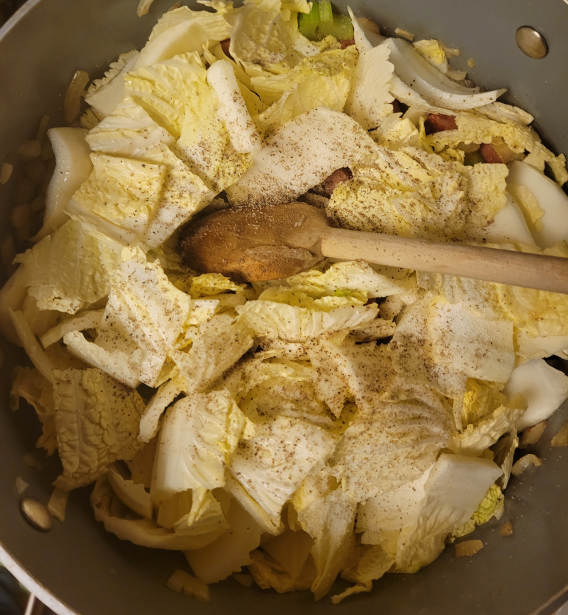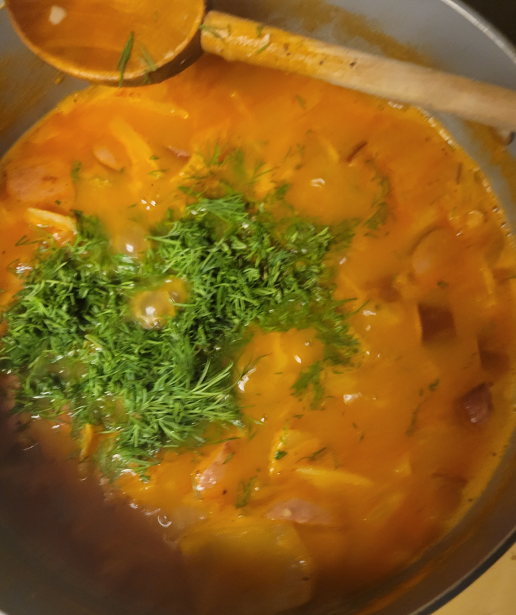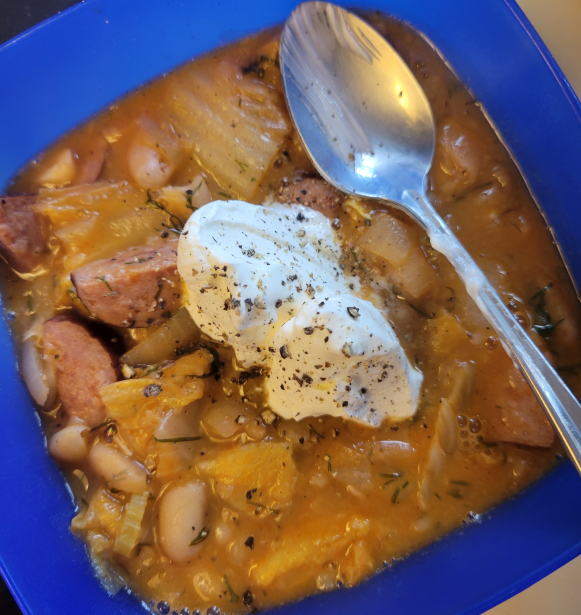KC 309 – K-Bas and Cabbage Soup

Why hello there, and welcome back to Kitchen Catastrophe, where we bake, broil, and babble until something beautiful comes out. I’m your Chaotic Chef De Cuisine, Jon O’Guin, and today’s recipe comes to us from a very interesting place that’s adjacent to several important things. So if you’re just here to eat and be on your way, here’s the link. For everyone else, let’s dig in. (Editor’s note: Sorry on the delay this week, everybody: We ran into a series of minor issues that just would not stop knee-capping us: Jon hasn’t been able to sit his family down together to plan recipes for weeks, a planned grocery trip got postponed due to bad weather, so Jon didn’t start cooking this until around 5:30 on Sunday, and then his Tech Week started, so Monday and Thursday night he had 4.5 hour rehearsals. He also spent some time figuring out how to navigate “I decided to make an Eastern European-inspired-dish the week Russia invaded Ukraine, so now I’ve got to deal with THAT”. He thinks he did…okay.)
Hard and Soft
Today’s recipe comes to us from the Inimitable Molly Baz, whom I once dubbed the “Hawkeye” of the Bon Appetit video crew. Which was, and remains, a compliment. (though I haven’t seen the Hawkeye show yet, so if that makes Hawkeye bad, forgive me my error.) In case you missed that post, or don’t want to read it now: Molly is a chef, video host, and recipe developer, who first appeared on my radar as part of the 2016-2019 Bon Appetit video ‘team’, a group of chefs working for Bon Appetit appearing in video content for the magazine’s YouTube channel. Following the scandal of the team (super condensed version: during the George Floyd protests, Bon Appetit put out a statement acknowledging the political nature of food, and how they as an organization would try to do better. This was quickly followed up by the revelation that in 2004, the editor in chief of the magazine had worn brownface to be “Puerto Rican” for Halloween. This led to further revelations that the Bon Appetit food team was not being equally compensated: that white chefs were paid for their appearances in others’ videos, while chefs of color were not.) Molly stated she would not appear in videos until the systemic discrepancies were addressed, and shortly thereafter left her staff position at the website (though she does contribute as a freelance writer). She has followed up with this cookbook, as well as a violently positive website.
The raw energy on display here sears my withered flesh.
I’ve actually had her cookbook, “Cook This Book” for…it feels like over a year, but checking the publication date, it has literally only been out for around 10 months, so I must be mistaken. In any case, I have considered cooking from it several times, and always found a reason to put it off for some other project. BUT NOT TODAY. Today we cook from it. And on Thursday, we can talk more about the cookbook itself.
But first, I want to get something out of the way: Obviously, things have happened in the last week that put a display of Eastern European cuisine in a sharper focus. I assure you, this is not a subtle post in support of Ukraine. By which I mean both that I do not intend to be subtle about my support for Ukraine, nor that I chose this recipe because of its association. I actually wanted to make a lemon-pasta dish from the same cookbook, but, as expected, the idea of a Kielbasa soup…oh, wait. Since I used her title for it, you probably didn’t know about that. Yeah, this is a Kielbasa (hence, “K-Bas”) and Cabbage Soup. My point was when brought up that one of the recipes I was considering was Kielbasa and Cabbage Soup, that became the one supported by my mother and brother. The connection is purely “a nice hearty soup feels more appropriate, given the cold and rain right now.”
But yes, I fully hope the conflict in Ukraine is ended soon to the benefit of Ukraine, with minimal loss of life on both sides. If you have the time and means here are some resources to help support the people of Ukraine. It is tragic that this is happening, and it is great to see people, especially the people of Russia, speak out against it. But that’s not the reason behind why I wanted to make this recipe…but given the context of the moment, I do think there’s one interesting point to draw out: the idea of “soft power” versus “hard power”.
Like the POWER OF DANCE?!
Actually, yes. And you may not know it, but this picture might make you cry in a minute.
If you’re unfamiliar with the terms, in politics/diplomacy, there is a relatively new (being coined in 1990) and somewhat contested term of “soft power”, based on a relatively simple premise: that there are ways of persuading people, or enacting national communication, that are co-operative. By which I mean that “hard” power is that of the bullet or the bullion: Either cold hard force, or cold hard cash. It is coercive power: you may not like me, but you’ll agree with me either because I will hurt you otherwise, or because you need me, financially. When nations impose sanctions, that is hard power. When they invade, that is hard power.
Soft power is the idea of co-optive, rather than coercive power. It’s giving people what they want, without demands, and building goodwill or sharing culture: food, music, art, even sometimes including money, if given selflessly/kindly: one of the most heart-warming recent displays of soft power was hundreds of thousands of dollars given the Navajo and Choctaw people for COVID relief from…Ireland. Because 175 years ago, the Choctaw, on learning of the Irish Potato Famine, sent $170 (the equivalent of $5,000 in today’s money) to help feed people, mere years after they themselves had endured the Trail of Tears. That act of kindness has been taught as a part of Irish history for decades, with a monument (pictured above)for it set up in 2017, 150 years after the money arrived. The Irish sent that money not because it was required of them by contract, but because they genuinely wished to repay an act of kindness. That is the heart of long-term soft power.
Other, less moving examples include that the US has a great deal of soft power, for instance, in part because of the power of Hollywood: other nations don’t NEED our movies and shows, but they like watching them. Korean K-Pop is soft power, because can you imagine how mad the BTS ARMY would be if anyone hurt one of their (nine? I think there are nine) boys? Thailand has been using a defensive form of soft power for decades, by directly sponsoring Thai restaurants around the world. Like, full honesty, I know almost NOTHING about the Thai government. I THINK I remember it’s a military junta where it’s illegal to criticize the King, because I believe John Oliver made some jokes about that like, 6-8 years ago. But if you told me that the US was bombing Thailand for human rights violations, it would upset me, because I love Thai food. I feel like I have some connection with the culture of Thailand, and thus oppose harm to it. Which was exactly their goal: Soft power corrodes hard power. It’s much harder to motivate people to inflict harm on those they care about, or whose culture they admire. If the US government tried to invade Canada, home of the continent’s most likeable Ryans, there would be mass protests.
The chants would be unbearable. “Let our Gosling Go!” or “Don’t kill the Deadpool!”
So, what does that have to do with today’s recipe? Well, ‘soft power’ is the exact kind of relationship that is so fundamental on a personal level: It’s doing something for a friend because you’re friends, not because it’s financially better for you. And it’s technically what motivated this post: I bought this cookbook because I liked Molly in the videos, and I liked her stand for what she thought was right. I’ve bought the cookbooks of EVERY former BA video staffer that’s put one out since leaving. (Except, I confess, Claire’s: not because I don’t support her, but because she’s a pastry chef, and baking scares me.)So let’s dive into this recipe, and see what’s happening.
Dump Da Dump
Firstly, the recipe is another version of what I call a “dump recipe”, as most soups are: it’s a one-pot recipe where most of the steps are “put Ingredient X in, wait a bit, put ingredient Y in.” For this recipe in particular, the first thing you’ll want is some kielbasa.
Now displayed as a meat-banana.
As we’ve mentioned before, “kielbasa sausage”, as it’s often called in America, is a bit of a misnomer: kielbasa is just the Polish word FOR sausage. All sausage is kielbasa in Poland. What Americans think of as Kielbasa is closest to a sausage known as wiejska, (vee-ey-ska) meaning “Country” or “Rural” Sausage. It’s not 100% clear on why this specific version caught on as THE kielbasa, though if I had to put money down, it would be basic utility and phonotactics: its’ the most distinctively shaped of the polish sausages, so it’s easier to assign that shape as “the polish one”/ it’s the one you can most easily re-identify to a Polish meat merchant by pantomime. And they would say something like “Ah, wiejska kielbasa”, and then people would be like “yeah, yeah, the kielbasa”, because that word is much “cleaner” for English rules than wiejska. The Poles would find it funny that other people only know how to order one type of sausage, and eventually it just sticks.
In any case, the sausage we call kielbasa is TRADITIONALLY pork and veal, though these days you typically get it all pork or all beef, and it’s flavored with marjoram, garlic, other herbs, and smoked. Molly talks about how it’s a flavor powerhouse, and dedicates the recipe to honoring its legacy.
You start off chopping up kielbasa, and then frying it for about 8 minutes, to render some fat out of it, really build fond in the pan, etc. while that’s happening, you chop up some celery, onion, and garlic, the Mirepoix of Munich.
The onion and celery looks kind of like Asia and Europe in this shot. That was not intentional.
Those all get dumped in with the sausage, and cooked off until the onion is translucent. The next step is where we up the Eastern European factor, by adding a pound of cut cabbage: molly’s version calls for green, but my family had 2 pounds of fresh napa cabbage we needed to use up (bought the week before for a President’s Day Hot Pot) so we went with that. The instruction is to add it with “2 tsps of salt, and lots and lots of freshly ground black pepper.” An instruction we followed with around 40 cranks on our pepper mill.
For context, this is about 30 cranks. So we got to here, and went 1/3rd FARTHER.
As the cabbage softens, you want to measure out some water, pop open and rinse off a couple cans of white beans, and prep a bit of tomato paste. Which might feel like a lot, but that’s the thing with these dump recipes: each step only takes a couple seconds. It can be daunting, looking at a recipe list of 12+ ingredients and 8 or 9 steps, but when you figure out that most of them are just “toss cheap thing X into pot at this point”, it’s not as bad as it seems at first. Like, prepping those three things actually got you ready for TWO steps, since you want to add and cook off the tomato paste before adding the beans and water. A lot of this process, done “right”, is “spend 15 minutes prepping at the start, and then just hang out in the kitchen and toss stuff in every now and again”.
Pretty standard for soups, really. “Just keep tossing stuff in until it’s done.”
Once you’ve got the water in, it’s time for the longest single step, AND probably the most involved step: see, now you’ve got to bring the water to a simmer, and let it simmer for 15 minutes. So that’ll probably take, depending on your stove-top, 20-25 minutes. And while that’s happening, you need to FURTHER INCREASE the Eastern European quotient of the recipe, by getting a cup of fresh dill leaves. Which I had to do by buying 2 packages of baby dill, and prying the sprigs off. Slightly more labor intensive than I’d like, but it’s something you can do between the other steps. I’ll also note that the recipe doesn’t call for the dill to be tightly packed or anything, and I felt like we had plenty of dill. (Our cup of dill, after chopping, was about 2/3rds of a cup with the saved space compacted.)
As it went into the pot, and I stirred it, I thought “this might be too much.”
The last thing you’ll need is sour cream, because of course it’s in this recipe. We already had dill, kielbasa, and cabbage, why would we leave rubles on the table? The sour cream is for dolloping in each bowl once you think the soup is cooked down and tasty enough: you ladle it into a bowl, dollop some cream, crack some more pepper, and drizzle a little olive oil on it, and boom, you’ve got a powerhouse of a soup.
True story: this is the THIRD bowl I’ve eaten in 4 days, because I apparently didn’t take a picture of the finished bowl the first time, or the second.
The result is very good, though I will make a recommendation that I don’t normally spare the time for: don’t skip the dollop. This soup, without the sour cream and last hit of pepper is good. But it’s good in the way that a basket of French fries is good: it’s not “complete”. Just as the fries need a sauce (whether vinegar, mayo, ketchup, whatever), just as a baked potato cries out for dairy and herbs, the soup calls for one last hit of fresh pepper, and the tang and creaminess of sour cream to make it great. The closest comparison I can make is chili con carne, and I wouldn’t blame someone from calling it “Polish Chili” to help a relative or family member try it. It’s porky instead of beefy, and instead of the intense spices (cumin, chili powder, etc), you have the homey flavors of broken down vegetables: celery, onion, garlic and cabbage, but where mixing sour cream into chili thins it, it thickens this soup to roughly the same place, pushing the textures and flavors into a space that made the connection obvious to me. I thoroughly endorse the recipe, and hope you give it a try sometime, preferably if it’s a cold and wet kind of day.
THURSDAY: EITHER WE TALK ABOUT THIS COOKBOOK, OR I TRY AND BUILD ON AN IDEA I JUST CAME UP WITH. I THINK THE COOKBOOK IS THE BETTER OPTION, BUT MAYBE NOT, BECAUSE IT MIGHT BE BETTER TO SAVE THAT FOR…FUTURE ISSUES. (BY WHICH I MEAN OF THE NEXT 10ISH DISHES I CURRENTLY HAVE PLANNED/BOUGHT INGREDIENTS FOR, 6 ARE FROM THIS ONE COOKBOOK, SO MAYBE I SHOULD WAIT AND MAKE MAY “MOLLY MONTH” OR SOMETHING.) LOOK, I HAVE PLANNING PROBLEMS.
MONDAY: I THINK THE TWO MOST LIKELY OPTIONS, ASSUMING IT’S NOT ANOTHER MOLLY RECIPE OR TWO, IS EITHER A GRILLED CHEESE THAT’S MORE THAN A LITTLE EXTRA, OR AN IMITATION OF AN IMITATION OF SOMETHING VAGUELY CHINESE.
Recipe
K-Bas and Cabbage Soup
Serves 4-6
Ingredients
2 celery stalks
6 garlic cloves
1 large yellow onion
1 pound green or napa cabbage
1 cup fresh dill leaves
12 ounces kielbasa
¼ cup olive oil
2 tsps salt and Freshly Ground Black Pepper
3 tbsp tomato paste
2 cans white beans
4 cups water
Sour Cream for serving (or whole-milk plain Greek Yogurt)
Preparation
Mise-en-place: thinly slice the garlic; cut up the onion; cut the celery into ¼ inch-thick half-moons; reduce the cabbage to quarters, cut out the core, and cut the leaves into 1” wide strips; split the kielbasa in half lengthwise, and cut each half into ½” wide half-moons.
Build the Base: Heat the oil in a large pot or Dutch oven over medium high heat. Add the kielbasa, and cook without moving for 4-5 minutes, to build a golden-brown crust and fond. Stir, and cook another 2-3 minutes. Add in the garlic, celery, and onion, and cook, lowering to medium heat, until onion is translucent, about 5 minutes. Add in the cabbage, salt, and A LOT of black pepper, tossing to coat cabbage in oil, and stirring often, until cabbage has softened, roughly another 5 minutes. Stir in tomato paste, and cook off for 2-3 minutes.
Add in beans and water, stirring to incorporate, and intentionally smashing around 1/3rd cup of the beans against the sides of the pot, so their released starch can thicken the soup. Return heat to medium-high, and bring to a simmer. Reduce the heat, and simmer 15 minute, until thickened.
Season with additional salt and pepper to taste. Ladle into bowls, and top with a dollop of sour cream, additional black pepper, and a drizzle of olive oil.














